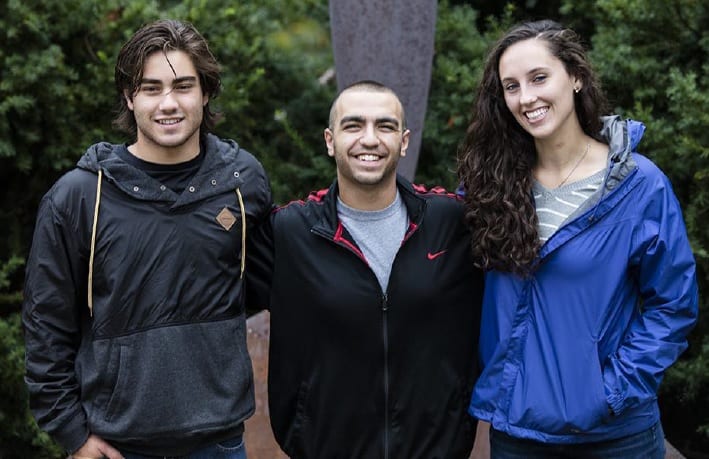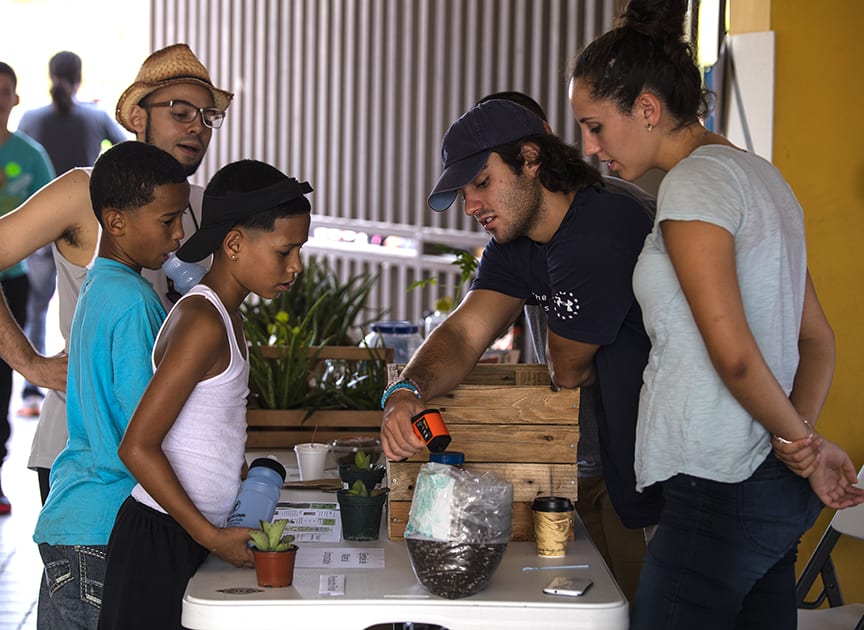Assessment of the Feasibility of a Composting Facility for the Cantera Community
 Sponsoring organization: Compañia para el Desarrollo Integral de la Peninsula de Cantera
Sponsoring organization: Compañia para el Desarrollo Integral de la Peninsula de Cantera
Team members: Tyler Kilkenny (Industrial Engineering ’17), Madelyn Werth (Mechanical Engineering ’17), Jake Nieto (Mechanical Engineering ’17)
Executive Summary: Global waste generation is expected to triple in the next hundred years according recent evaluations of the increasing production of garbage (Goto 2013). Without drastic efforts to decrease generation, recycle and reuse, these levels of improperly handled waste will overwhelm populations around the world. Currently less than 4% of the solid waste stream is recycled in poverty stricken communities (Hoornweg & Bhada-Tata, 2012). Efforts to increase this percentage of recycling have the potential to contribute towards a solution to these garbage problems by repurposing waste to create new resources. In Puerto Rico, an island territory with limited waste disposal options, average waste production amounts are 1.2 times higher than average U.S. mainland residents. Problems that result from improper management and lack of recycling of these large volumes of waste are amplified in regions with high poverty levels and poor infrastructure. There is evidence of this relationship in the Cantera Peninsula where substandard living conditions exist.
The Cantera community struggles with both high poverty levels and insufficient infrastructure for waste management and utilities. Sections of resident houses were constructed on unstable land that was created by a buildup of trash dumped in what used to be the flowing Martín Peña Canal. The canal’s natural flow has been significantly hindered since the 1980s resulting from a long standing habit of negligent waste management practices. These habits have created a reputation of Cantera as an area to dispose of unwanted waste; outside individuals frequently use the region as a dumping ground. These practices have lead to many negative effects on the environment due to pollution and the disruption of the natural flow between the ocean and the lagoon that should be connected by the Martín Peña Canal.
To address these issues, we investigated how composting can improve waste management issues in Cantera in collaboration with the Compañía para el Desarrollo Integral de la Península de Cantera (CDIPC). The CDIPC is a government organization that strives to improve the environmental, social, and infrastructural conditions throughout Cantera. Our project is a continuation of previously developed plans for the implementation a waste collection facility from a 2014 IQP: Evaluation of the Feasibility of Establishing a Waste Collection Facility to Serve the Community of Cantera. Building off of this past project and using new methods aimed at collecting data on the current waste disposal practices and opinions in the area has allowed us to establish the feasibility of a composting plant in Cantera.
Our goal for this project was to determine the feasibility of a composting plant that will improve waste management habits to support the CDIPC’s efforts to create a more sustainable community. We achieved this goal by completing three main objectives:
- Create a plan to connect with the community and gain their support for a composting facility by educating about sustainability and
- Investigate other composting efforts to gain knowledge about the composting process and how to make a profit from
- Develop protocols for the successful operation of a composting facility in
To create a plan for community involvement we evaluated the current attitudes on waste management and waste disposal habits of the community. We did this through a tour of the community, meeting with local middle school students, and participating in a local event. The tour was led by Alfredo Zapata, a CDIPC employee who has created strong connections throughout Cantera. He was able to highlight issues that residents are currently dealing with and their willingness to accept new sustainability efforts. Next, we met with local middle school students to generate methods to reach out to the community and gain support for new ideas.
From student feedback, we developed informational sheets to provide basic knowledge about composting. The effectiveness of this material was then tested at a local event, the December 6, 2015 Bike Day.
To determine the feasibility of a composting plant, we met with community stakeholders and other composting operations in Puerto Rico. Community stakeholders included other CDIPC employees, with experience on the conditions in Cantera, and the San Juan Municipality. The Municipality was especially beneficial because their representative expressed interest in a potential partnership with a composting facility. The other composting operations we observed and participated in were the industrial composting operation at Vivo Recycling and a small garden compost process at the local middle school. Our visit at Vivo Recycling was a great opportunity because it is a successful business built around composting, which we hope to be able to repeat in Cantera.
After the feasibility was established, protocols for the operation of the facility were planned out by researching, observing, and identifying the basic steps of the composting process. We started by researching the fundamentals of composting. This was used to create a system to compare various compost organization methods that were identified and determine the most applicable method for Cantera. By observing the process at the local Vivo Recycling composting plant we were able to recommend a similar type of facility for Cantera. The next step was meeting with the local San Juan Municipality to understand what kind of partnership the facility could have with already established waste collection systems and what kind of legal permits are required. From the collected information, we were able to set up an efficient and reliable composting plan for a new facility in Cantera.
Results
This project includes an assessment of the current waste management situation in Cantera and an explanation of how introducing composting would be beneficial to the community. A plan for a composting facility is also outlined as follows:
1. Evaluation of the current waste management situation in Cantera
From the tour around the Cantera Peninsula, we learned about common practices of open dumping and were able to see the build up of trash in certain areas. Seeing the conditions throughout Cantera showed how the current waste management practices are not effective. We then talked with students at the local middle school and learned about the limited common knowledge about recycling methods, like composting. From our discussions, we learned about the attitudes that residents have and how to best approach changing them. The student’s interest in environmental issues, learning, and sharing knowledge showed promise for improvement of the waste management habits in Cantera. Talking with the students allowed us to generate educational materials that will help explain the concepts of composting and how it could be implemented in Cantera. One example of educational material is shown below in Figure 1.
2. Assessment of a potential composting facility
Assessing the feasibility of the composting facility was completed through discussions with Vivo Recycling and the San Juan Municipality. Vivo Recycling is an established industrial composting plant located in Caguas, Puerto Rico. Our tour with Vivo helped us identify four factors for a successful composting business. These factors include:
- Community need for organic waste disposal
- Partnership with local municipality
- Distribution of revenue
- On site nursery
Cantera has the potential to build from the presence of these four factors and establish its own facility. This is demonstrated by the interest of the local San Juan Municipality. Through a meeting with a municipality representative we found that there is a need for a composting facility. We learned that they would be eager to work with a local composting plant to revert recyclable organic waste from its current disposal method: landfills. We found that a facility could create more sustainable habits for the community and maintain a profitable business.
3. Explanation of required composting protocols
In order to prepare for the future facility in Cantera, four steps of composting were identified:
- Sorting
- Creating a Pile
- Maintaining
- Separating
We designed these steps through research and confirmed them through observing both the Vivo Recycling facility and the local school’s garden. We then compared multiple composting organization techniques to choose the most applicable one for Cantera. By comparing the systems, we found the two best methods to be compost piles and holding units. These two organization methods would be implemented during different phases of the three-tiered facility plan. An outline of the three tiers can be seen below in Figure 2:
Recommendations
We identified recommendations to increase the reception of a community-composting plan based on the analyses of our results. We focused our recommendations on the education of composting concepts in Cantera to encourage progress towards the implementation of a composting facility.
- We recommend disseminating the basic knowledge of composting concepts to residents in the community of Cantera.
A large importance to the implementation of the composting program and facility is the community understanding the composting process. We created pamphlets and handouts outlined in both Appendix I and Appendix H that would create a basic understanding of the composting process. The informational material should be handed out at schools and community events. The individuals delivering the information need to be established as a trustworthy source with connections to the CDIPC. After interaction with the material, residents’ knowledge will then be assessed through interactive activities. Once residents are engaged in the learning of composting, the plan for the implementation of a facility will hopefully gain support.
- We recommend the implementation of a compost
This should be implemented by the CDIPC along with a partnership with local community leaders. Some funding for the facility could be generated through a partnership with the San Juan Municipality. The composting facility location will be where the community can come together and work in a common area. The techniques of composting that we have provided will be utilized at the site. The overall layout of the site will include a learning center, garden, and process of composting. The layout can be seen in Figure 3, below.
A key aspect of Figure 3 is the four steps of composting that are necessary to complete the process.
- Our recommendations for future projects
We suggest that a future team research more into the capabilities of an industrial scale facility plan for Cantera. They should analyze the maximum size Cantera’s potential facility can reach and how much waste could be handled. We also suggest that future investigators look into a private business investor or find government funds to develop an industrial grade composting facility. Lastly, we recommend future investigators work with the San Juan Municipality gain more detail on specific permits. This will be a critical aspect on planning out the industrial grade facility and gaining approval to move forward on the project.



